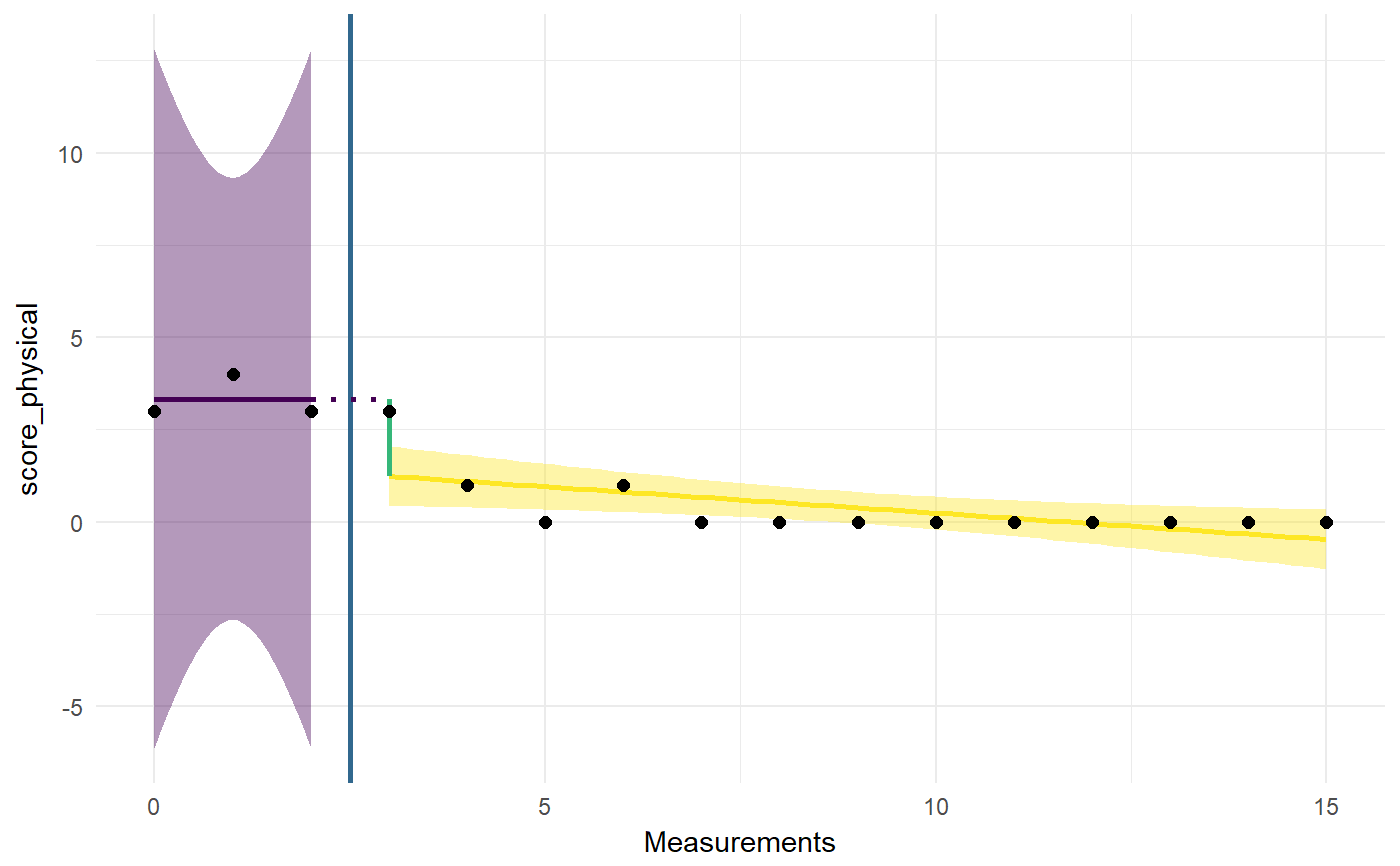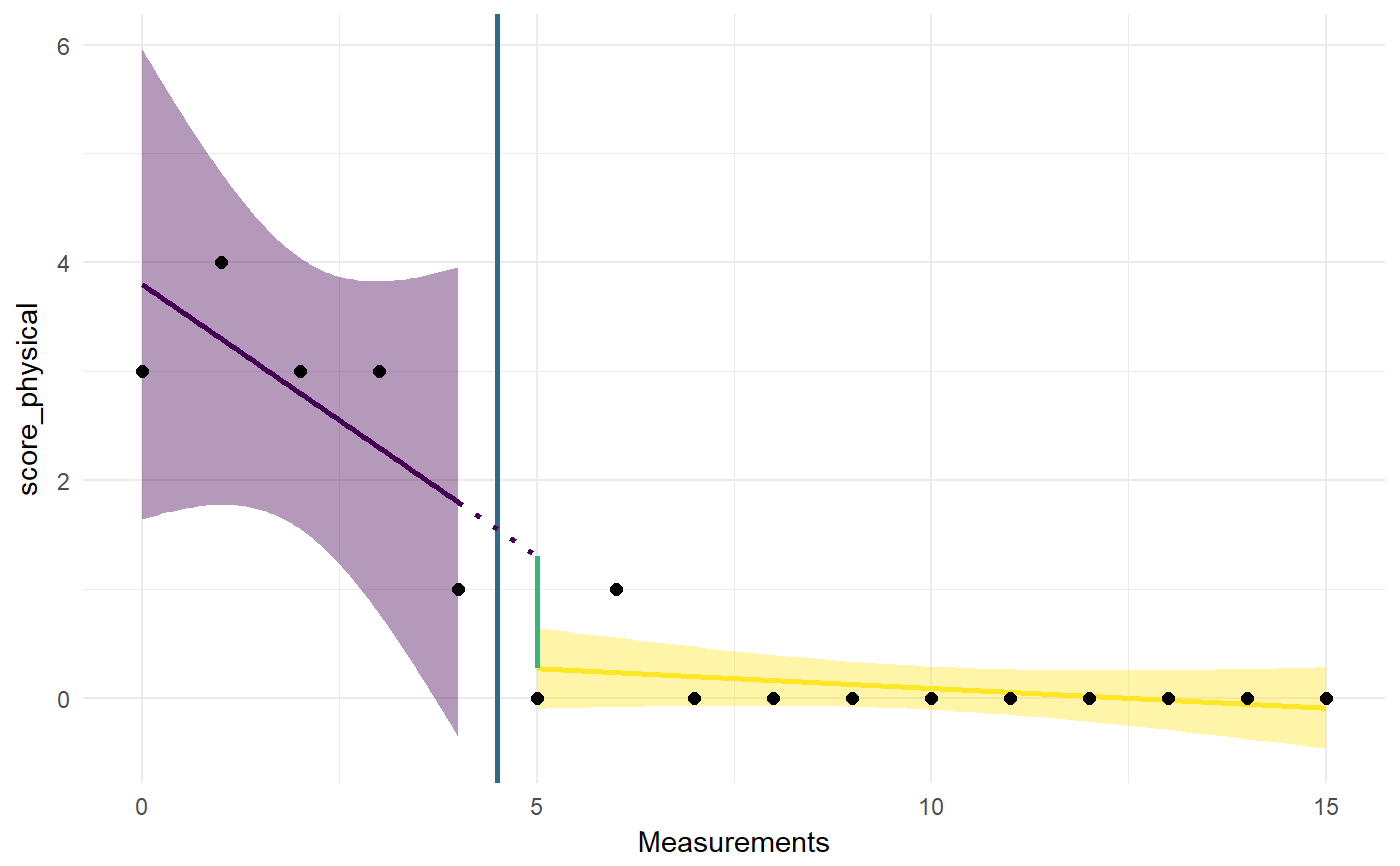Piecewise regression analysis
This function conducts a piecewise regression analysis and shows a plot illustrating the results. The function enables easy customization of the main plot elements and easy saving of the plot with anti-aliasing.
piecewiseRegr(data, timeVar = 1, yVar = 2, phaseVar = NULL, baselineMeasurements = NULL, robust = FALSE, digits = 2, colors = list(pre = viridis(4)[1], post = viridis(4)[4], diff = viridis(4)[3], intervention = viridis(4)[2], points = "black"), theme = theme_minimal(), pointSize = 2, pointAlpha = 1, lineSize = 1, showPlot = TRUE, plotLabs = NULL, outputFile = NULL, outputWidth = 16, outputHeight = 16, ggsaveParams = list(units = "cm", dpi = 300, type = "cairo"))
Arguments
| data | The dataframe containing the variables for the analysis. |
|---|---|
| timeVar | The name of the variable containing the measurement moments (or an index of measurement moments). An index can also be specified, and assumed to be 1 if omitted. |
| yVar | The name of the dependent variable. An index can also be specified, and assumed to be 2 if omitted. |
| phaseVar | The variable containing the phase of each measurement. Note that this normally should only have two possible values. |
| baselineMeasurements | If no phaseVar is specified, |
| robust | Whether to use normal or robust linear regression. |
| digits | The number of digits to show in the results. |
| colors | The colors to use for the different plot elements. |
| theme | The theme to use in the plot. |
| pointSize,lineSize | The sizes of points and lines in the plot. |
| pointAlpha | The alpha channel (transparency, or rather, 'opaqueness') of the points. |
| showPlot | Whether to show the plot or not. |
| plotLabs | A list with arguments to the |
| outputFile | If not |
| outputWidth, outputHeight | The dimensions of the plot when saving it (in units specified in |
| ggsaveParams | The parameters to use when saving the plot, passed on to |
Value
Mainly, this function prints its results, but it also returns them in an object containing three lists:
The arguments specified when calling the function
Intermediat objects and values
The results such as the plot.
References
Verboon, P. & Peters, G.-J. Y. (2018) Applying the generalised logistic model in single case designs: modelling treatment-induced shifts. PsyArXiv https://doi.org/10.17605/osf.io/ad5eh
See also
Examples
### Load dataset data(Singh); ### Extract Jason dat <- Singh[Singh$tier==1, ]; ### Conduct piecewise regression analysis piecewiseRegr(dat, timeVar='time', yVar='score_physical', phaseVar='phase');#> Piecewise Regression Analysis (N = 16) #> #> Model statistics: #> #> Model deviance: 6.03 #> R squared for null model: .66 #> R squared for test model: .81 #> R squared based effect size: .42 #> #> Regression coefficients: #> #> Intercept: [1.92; 4.74] (point estimate = 3.33) #> Level change: [-4.59; 0.4] (point estimate = -2.09) #> Trend phase 1: [-1.09; 1.09] (point estimate = 0) #> Change in trend: [-1.24; 0.96] (point estimate = -0.14)### Pretend treatment started between measurements ### 5 and 6 piecewiseRegr(dat, timeVar='time', yVar='score_physical', baselineMeasurements=5);#> Piecewise Regression Analysis (N = 16) #> #> Model statistics: #> #> Model deviance: 3.06 #> R squared for null model: .66 #> R squared for test model: .9 #> R squared based effect size: .71 #> #> Regression coefficients: #> #> Intercept: [2.95; 4.65] (point estimate = 3.8) #> Level change: [-2.34; 0.28] (point estimate = -1.03) #> Trend phase 1: [-0.85; -0.15] (point estimate = -0.5) #> Change in trend: [0.1; 0.83] (point estimate = 0.46)

